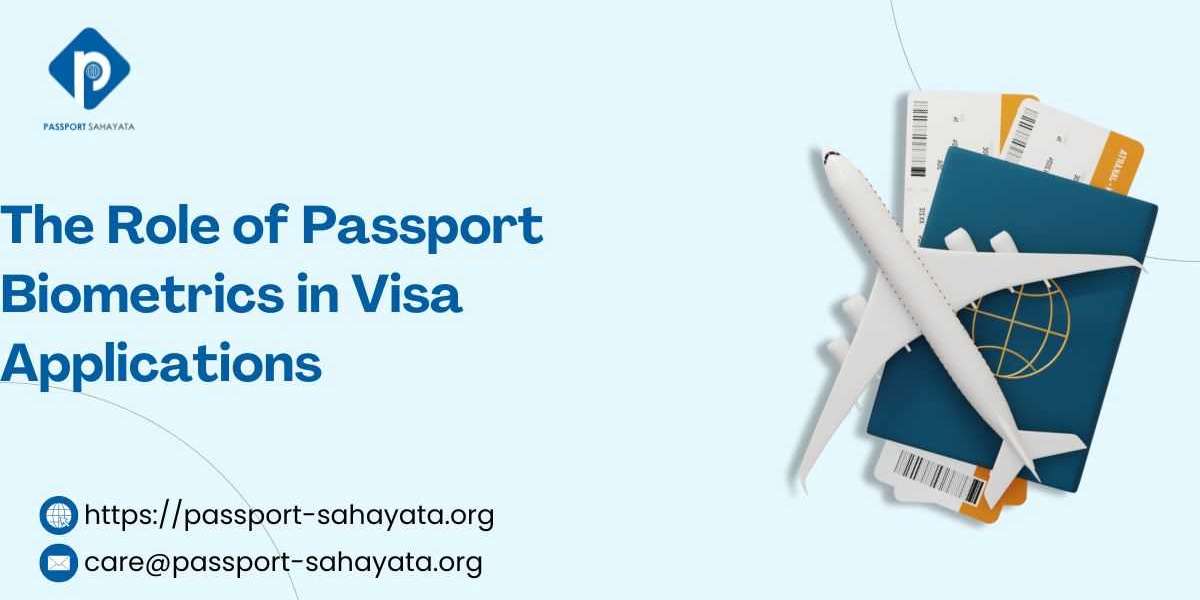In the contemporary era of digital globalization and heightened security awareness, passport registration online has emerged as a transformative force in the way countries manage and process visa applications. Biometrics—unique physical or behavioral characteristics such as fingerprints, facial features, and iris patterns—are increasingly being integrated into passport systems to enhance identity verification and reduce fraudulent practices. This technological integration has had a profound impact on visa processing efficiency, accuracy, and security.
What Are Passport Biometrics?
Passport biometrics refer to the embedded biometric data stored in electronic passports (also known as e-passports). These data typically include a high-resolution digital photograph, fingerprint scans, and sometimes iris scans. Stored in a secure chip within the passport, this information enables automated and accurate identity checks by immigration authorities. Unlike traditional methods that rely solely on physical documents and human inspection, biometric passports leverage digital technology to validate a person’s identity based on immutable biological traits.
Evolution of Biometric Integration
The adoption of biometric features in passports gained momentum following global security incidents such as the 9/11 attacks. The need for stronger, more reliable identity verification systems prompted the International Civil Aviation Organization (ICAO) to standardize e-passport features. Since then, countries worldwide have moved towards biometric systems to harmonize border controls and bolster internal security.
This shift has revolutionized visa application systems. Consulates and immigration departments now require applicants to submit biometric data during the application process, either at visa application centers or embassies. This data is cross-verified with national and international criminal databases, watch lists, and previous visa history to determine admissibility.
Streamlining the Visa Application Process
One of the primary benefits of biometric technology in visa applications is process streamlining. By capturing and storing applicants’ biometrics early in the application process, consular officers can quickly and accurately verify identity. This reduces the risk of duplication and identity fraud, both of which are common in paper-based systems.
Biometric verification also allows for quicker processing at border entry points. E-gates and automated immigration kiosks can read the biometric chip, compare it with a live scan of the traveler’s face or fingerprint, and grant or deny entry within seconds. This not only accelerates the entry process but also minimizes human error and subjectivity.
Enhancing Border Security
Security is the cornerstone of biometric passport systems. Biometric data are extremely difficult to forge, unlike traditional photo IDs. In visa applications, biometrics serve as a second layer of identity verification that supports document authentication. For example, even if a person manages to forge a passport or visa, they would still need to match the biometric data stored in the system, which is highly improbable.
Governments use biometric data to run background checks against databases maintained by law enforcement, intelligence, and immigration authorities. This helps in flagging individuals with criminal records, previous deportations, or suspected involvement in illegal activities. Consequently, the risk of letting in high-risk individuals through legal immigration channels is significantly minimized.
Supporting International Cooperation and Data Sharing
Biometric systems also facilitate greater cooperation between countries. Through shared databases and interoperable technologies, nations can share biometric data of visa applicants with partner countries. This cross-border collaboration strengthens global efforts to combat transnational crime, terrorism, and human trafficking.
For instance, the Schengen Information System (SIS) used by European Union countries enables data sharing about visa applicants and travelers, including biometric identifiers. Similarly, countries in the Five Eyes alliance (United States, United Kingdom, Canada, Australia, and New Zealand) often collaborate on biometric data to screen and vet applicants more effectively.
Challenges and Concerns with Biometric Data
While passport biometrics offer substantial benefits, they also raise concerns—especially around data privacy, ethical usage, and cybersecurity. Collecting biometric information involves handling highly sensitive personal data, and any breach or misuse could have severe consequences. Hackers targeting biometric databases could potentially access irreplaceable personal identifiers that cannot be changed like passwords.
Furthermore, there are concerns over consent, especially when applicants are unaware of how long their data will be stored or with whom it will be shared. Ethical debates also revolve around surveillance, with fears that biometric systems may be used beyond visa and immigration purposes, thus infringing on civil liberties.
To address these concerns, many countries have adopted stringent data protection laws and operational protocols. Encryption, access controls, and regular audits are enforced to safeguard biometric data. Moreover, international standards such as those set by the ICAO and the General Data Protection Regulation (GDPR) of the European Union play a crucial role in ensuring biometric data is used responsibly.
The Rise of Contactless Biometrics
The COVID-19 pandemic accelerated the adoption of contactless biometric systems, particularly facial recognition. Visa application centers and airports worldwide started favoring contactless methods to reduce physical touchpoints. Facial recognition, in particular, gained traction because it allows verification from a distance without needing applicants to touch any surfaces.
This shift not only ensured hygiene and safety but also improved user experience. Contactless biometrics now enable remote enrollment for visa applications in some countries, where applicants can upload a facial scan through secure mobile apps or online platforms. While still in the early stages, this innovation may redefine how visas are issued in the future.
Biometric Verification and Multiple Visa Entries
Biometric passports and visa systems are especially advantageous for travelers who require frequent or multiple entries. Once an applicant’s biometric data is captured and stored, subsequent entries into the country can be processed faster, as the data does not need to be re-collected each time. This simplifies repeat travel for business professionals, frequent flyers, and expatriates.
In addition, biometric systems help immigration authorities track visa overstays and monitor compliance. By linking entry and exit data to a traveler’s biometric profile, authorities can automatically flag individuals who remain beyond the validity of their visa.
Biometric Passports and Visa Waiver Programs
Many countries offer visa waiver programs for citizens of select nations, allowing them to enter without applying for a visa. Even in such programs, biometric passports play a crucial role. For instance, under the U.S. Visa Waiver Program, eligible travelers must possess a biometric passport to qualify for entry.
The embedded biometrics serve as a security measure, replacing the need for a traditional visa while still ensuring identity verification. This helps countries maintain open borders for low-risk travelers while upholding stringent security protocols.
Impact on Consular Workflows
Consular officers and visa officials have also benefited from the adoption of biometrics. Decision-making has become more data-driven, and the risk of manual errors has significantly reduced. With the help of biometric screening tools, consular staff can focus more on evaluating the credibility of applicants rather than being burdened with redundant identity verification procedures.
Moreover, digitization supported by biometric integration allows for centralized visa processing. Applications can be reviewed and approved remotely with the assurance that the biometric identifiers match the person submitting the documents.
Looking Ahead: The Future of Biometric Visas
As technology continues to advance, the role of biometrics in visa applications is poised to grow even further. Emerging innovations such as behavioral biometrics, gait recognition, and artificial intelligence-based analysis may soon become part of the visa ecosystem. These technologies could make the identity verification process even more accurate and resilient to fraud.
Blockchain is also being explored as a method to enhance the integrity of biometric data. By decentralizing data storage, blockchain could prevent single-point failures and enhance transparency in how data is used and shared.
In the long run, the goal is to build a seamless, secure, and interoperable global travel system that relies on biometric identity verification as its backbone. This vision includes fully automated visa approvals, biometric-only travel corridors, and smart borders that rely on real-time biometric recognition.
The process to apply for passport
- Visit the Official Website – Go to the passport portal and start your application.
- Choose Passport Type – Select a regular or urgent (Tatkal) passport.
- Fill out the Form – Enter your details correctly.
- Submit the Form – Review and submit your application.
- Pay the Fee – Complete the online payment.
- Get a Reference Number – Use it to track your application.
- Book an Appointment – Schedule a visit to the passport office.
- Police Verification – Authorities will confirm your identity and address.
- Receive Your Passport – Collect it after processing.
Note:- Now you can easily apply for Tatkal passport
Conclusion
Biometric passports have revolutionized the visa application process by introducing a robust and reliable system of identity verification. Their integration enhances border security, streamlines visa processing, supports international cooperation, and improves traveler convenience. Despite ongoing concerns around privacy and ethics, the benefits of biometrics in modern immigration systems are substantial and far-reaching.
As nations continue to refine and adopt biometric technologies, the future of visa applications looks increasingly efficient, secure, and connected. In a world where cross-border mobility is both an opportunity and a challenge, biometrics provide the critical infrastructure for managing travel with confidence and integrity.







